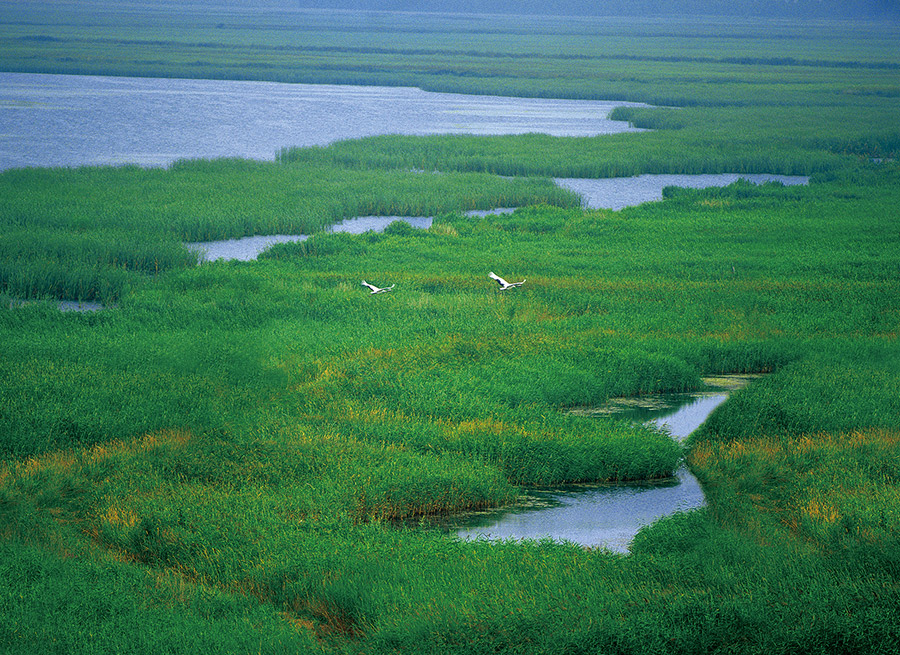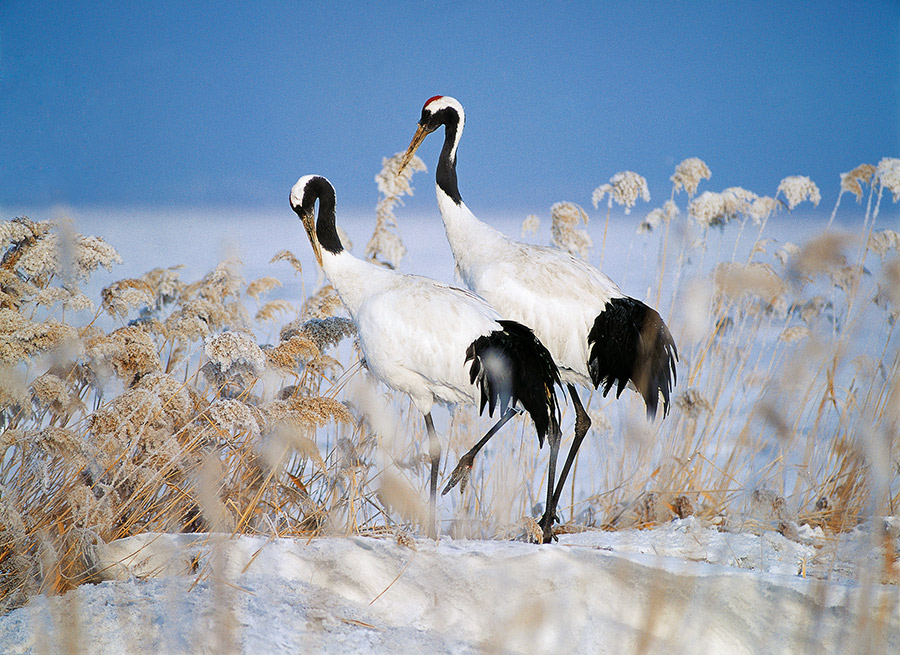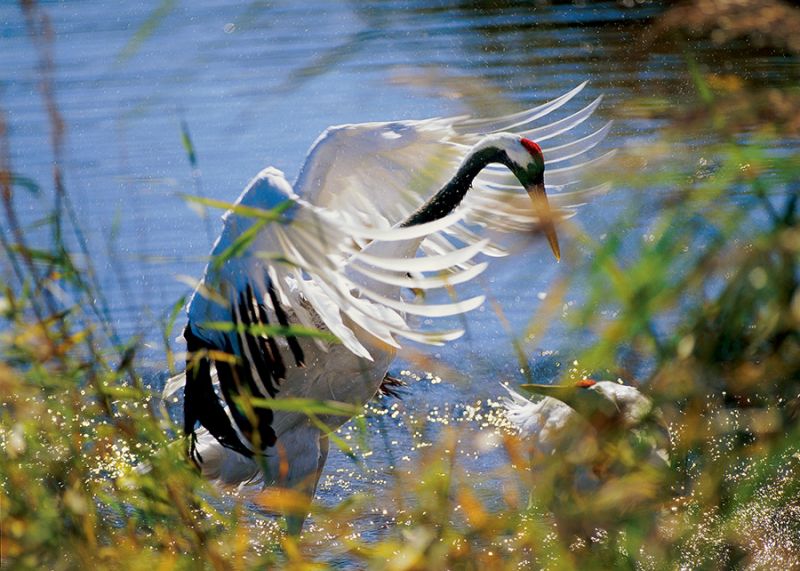Chinese for University Staff and MMS
Learn more
Through the lens of the photographer Mr Wang Keju and his passion for wildlife protection, the photographic exhibition "Love Between Two Cranes", in Mr Wang's own words, tells an epic love story between two red-crowned cranes: Dream (father crane) and Cloud (mother crane) in Zhalong Wetland, northeast China. Their story was beautifully captured by Mr Wang over a period of 7 years.
"Wang Keju has followed the wild cranes through the seasons and has selected his photographs and ordered them to express stories of unique birds he has personally known... stories of a crane losing its mate, of the fate of a lone crane, of a family with one strong chick and one that falters. Through stories he brings us another highly personal understanding of cranes, whose lives are not entirely different from those close around us: friends, relatives, ourselves."
James Harris, Vice President,
International Crane Foundation
Born in 1959 in northern China, Mr Wang used to work at the Corporate Culture Department of CRRC Qiqihar Rolling Stock Co. Ltd. Due to the proximity of the wetland where he worked and the nature of his work, he has been studying and photographing red-crowned cranes for more than 20 years.
He is now a famous environmentalist, international crane expert and renowned photographer for International Crane Foundation. Mr Wang is known as the father of red-crowned cranes in China.
An artist of Chinese national treasure level, in 2017 Mr Wang was named a Top Ten Global Chinese Cultural Persons by the Chinese Culture Promotion Society and Phoenix Satellite Television.

Zhalong Wetland is in Heilongjiang province in northeast China. Established in 1979, Zhalong Nature Reserve is renowned for its previous waterfowl conservation, with a total area of 210,000 acres.
Almost covered with water reed, Zhalong Wetland is a natural paradise for waterfowl due to its climate and geographic characteristics. Zhalong Nature Reserve home to more than 296 different kinds of birds, the majority being cranes.

The red-crowned crane (simplified Chinese: 丹顶鹤- pinyin: ‘dāndǐng hè’. The Chinese character ‘丹’ means ‘red’, ‘顶’ means ‘crown’ and ‘鹤’ means ‘crane’) is a large east Asian crane, among the rarest cranes in the world.
In China, the red-crowned crane is often featured in myths and legends, as a symbol of luck, longevity, and nobility. In art and literature, immortals are often depicted riding on cranes. Red-crowned cranes are called fairy-crane or crane of the immortals (simplified Chinese: 仙鹤 - pinyin: ‘xiānhè’).
The red-crowned cranes have a lifespan of up to 70 years and they mate for the first time at around three or four years of age. A mating pair then remain partners for life.

Prelude:
“For twenty years, this wetland has been a friend of mine, everything here has been part of my life and the story of Crane ‘Dream’ and ‘Cloud’ started on this magic land… In the morning, the world was still in peace. The sun rose from the horizon, a horde of red-crowned cranes were chanting. Harmony was everywhere in the fairyland – Zhalong Wetland”

Dream (father crane) and Cloud (mother crane) came into the world in 1982 as part of a breeding program for this endangered bird. In 1999, Dream, the tall crane with graceful temperament, had attracted my attention. Every time I went to feed the cranes in the feeding zone, he was the only one who did not scramble with the others. Dream always strolled towards me and started eating his food only after touching my hand by his beak to show his gratitude.

Chapter 1: Falling in Love.
“The lake was their playground. After having some fun in the water, Dream would always shake off the water on his wings and embrace his wife with passion. Cloud, in return enjoyed her husband’s affection and always hugged him back with love.”

Dream and Cloud stood together to appreciate the rainbow.

Chapter 2: Romantic Proposal.
“Early spring was the proposal season for red-crowned cranes. They expressed their love through dancing. Dream found one piece of flower for Cloud and danced with this love token around his beloved wife.”

“After dancing in free style, Dream started his ballet move on snow under the loving eyes of Cloud.”

Chapter 3: Deep Love to their Children.
“Water Reed was thriving around the lake in summer. Dream and Cloud took their two sons for food hunting along the lake. Dream was preening his feather whilst Cloud was feeding her son with fish. The elder one ran ahead and the younger one staggered behind his brother.”

“The two little crane babies were practising their skills in foraging for food, as if they were showing brotherly bond with each other. The younger one was weak and always in a disadvantaged position. I was quite concerned about the younger crane baby as he was born weak, and I often prayed for his health.”

“Unfortunately, what I worried about to come true. The younger crane baby died in one windy and rainy night. Dream and Cloud consoled each other in great sorrow.
“After the younger son died, the parents paid much more attention to the elder one. One sunny day on the grassland with blooming flowers, the son looked up into his father’s eyes, seemingly to console his father. Dream set his hope on the only son.
"A new year marked the new beginning. When the spring had arrived, Cloud gave birth to two new babies. Everything went well in the family."

Chapter 4: In Sickness and in Health.
“One winter day, the misfortune fell onto Cloud. The family were wandering around on the icy lake surface as usual. While Cloud was foraging from the ice cracks, her beak broke due to the freezing temperature. Beak was very important for cranes’ survival, a broken beak could be disastrous to Cloud, and to the family. How could Cloud survive in the coming days? I was extremely worried for her.
“Quickly, I realised my concerns were totally unnecessary. From the day that Cloud broke her beak, Dream started to look after her very carefully.”

“Dream preened his wife’s feather with tenderness every day. The feather covered the exterior of the body needed to be preened reversely. Dream had to turn his head upside down to complete the job. Cloud would rest her head into her wings at this time, enjoying the love from her husband.”

Chapter 5: Till death do us part.
“Nobody could foresee that crane’s fate was as uncertain as the changing weather.
“One afternoon in March 2005, Dream stood at the top of the island, screeching sadly. My heart sank…something had happened to Cloud, I guessed that Dream could not find Cloud, so he got back to their usual habitat and hoped to find his wife.”

“Dream kept searching on the island with his children, and they called together, looking afar anxiously, expecting Cloud could be back to them.
“Dream kept searching for his wife day after day tirelessly. He searched every place they had walked together, called from the bottom of his heart thousands of times. However, never did his wife again appear in his sight.”

Chapter 6: I will see you in my dreams.
“Searching the region myself for more than twenty days, I finally found Cloud but only her carcass. Judging from my experience, Cloud had to be killed by foxes. Although I had thought of this the moment I saw her dead body, I could not help but burst into tears.
“I sincerely hoped that Dream could continue his pursuit of happiness, rather than follow the death of Cloud. To protect Dream from seeing the heart wrenching tragedy, I choked back tears and buried Cloud.”

“From spring to summer, Dream stayed at his territory alone, yearned for his wife with tears. After a summer storm, the rainbow hanged in the sky once again. Dream had a look then walked away sadly. This scenery was the favourite of his wife, but where art thou, my darling Cloud?
“After three screeches, Dream waved his wings with force, flew into the sky, and became smaller and smaller in my sight. Dream had left, with deep love to his wife and the homeland. He had chosen to pursuit his life into the unknown.”
The photos and Illustrations are abstracted from the Book "Love Between Two Cranes" by Mr Wang Keju.
Copyright © 2020 - all rights reserved
Back to Newcastle China Week 2020
The University of Newcastle acknowledges the traditional custodians of the lands within our footprint areas: Awabakal, Darkinjung, Biripai, Worimi, Wonnarua, and Eora Nations. We also pay respect to the wisdom of our Elders past and present.